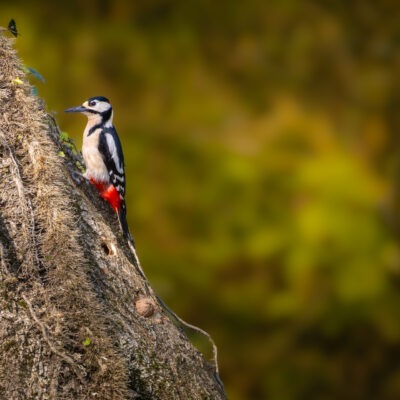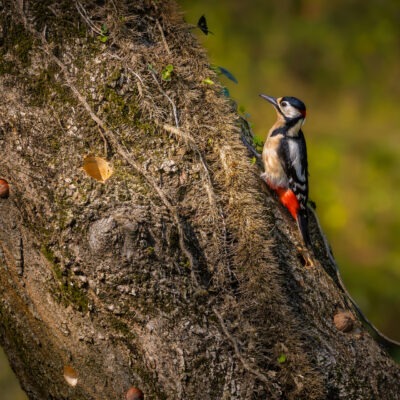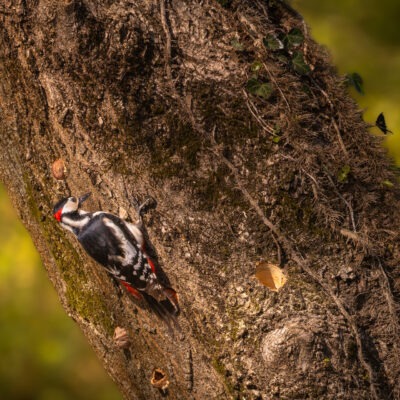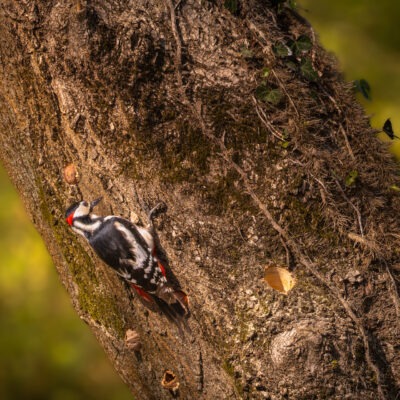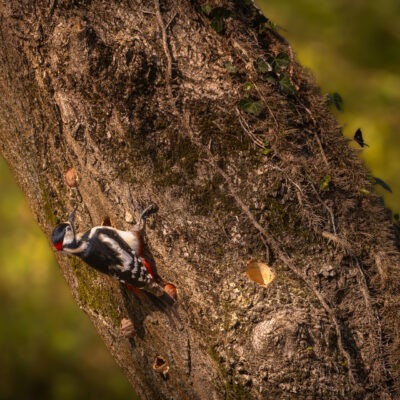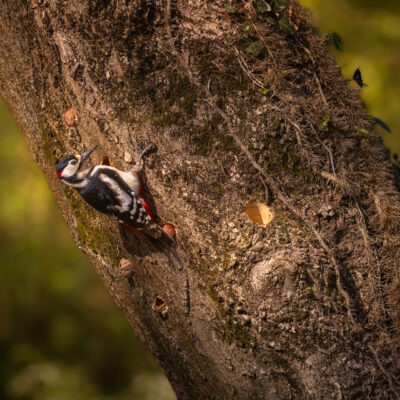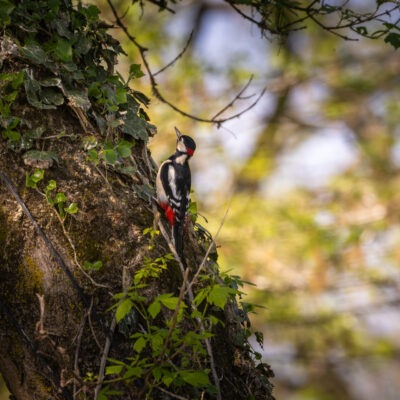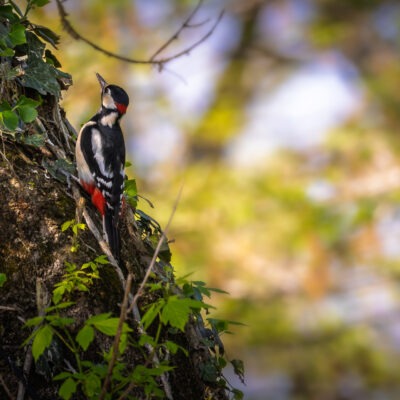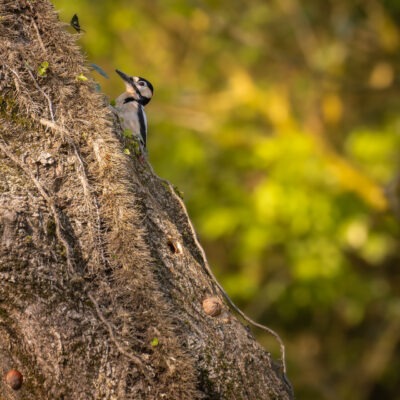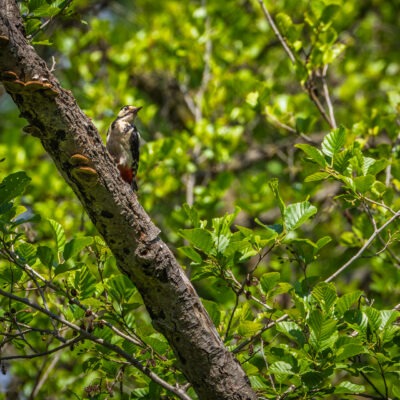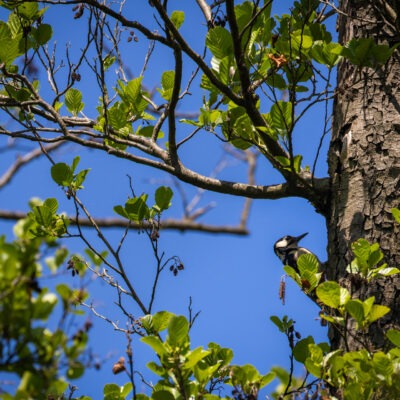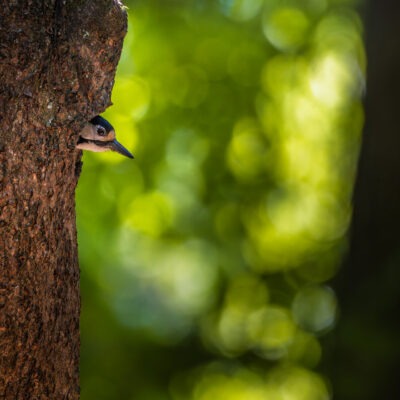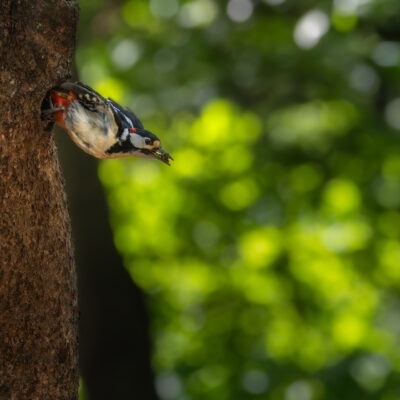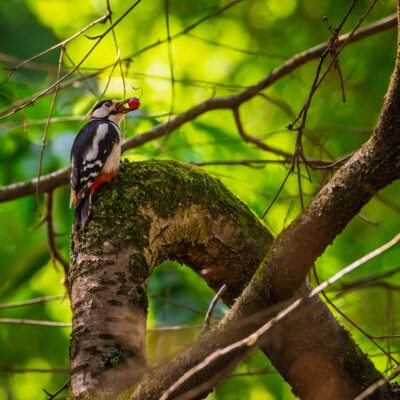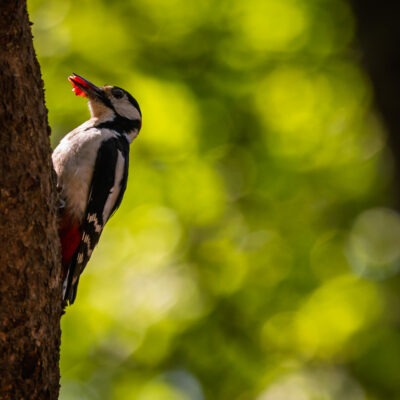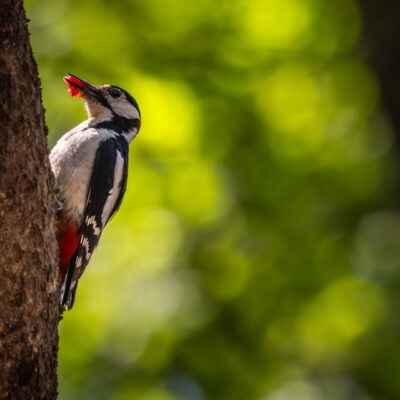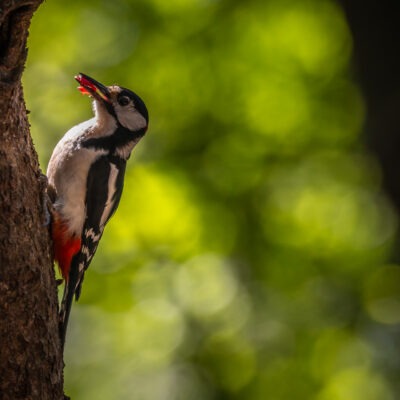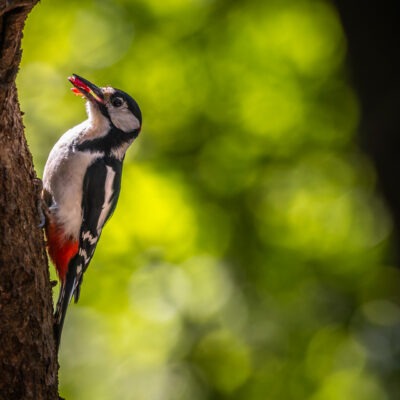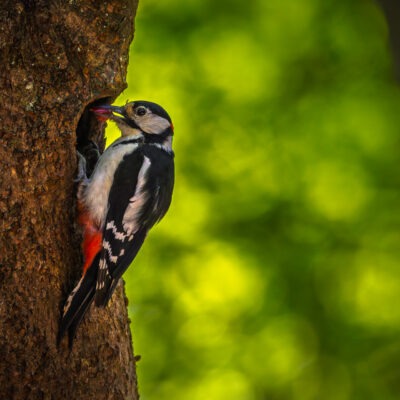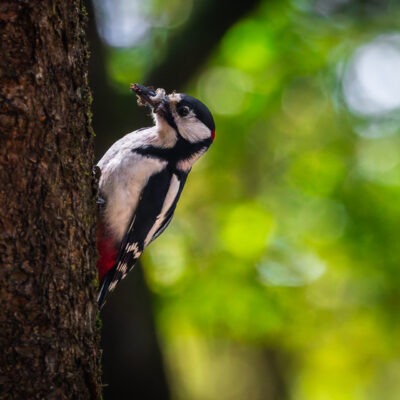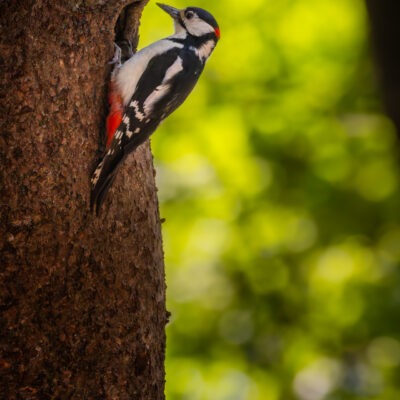Great Spotted Woodpecker: The Winged Drummer of Our Woods!
Walking through the woods of Lombardy in these first weeks of spring, it’s almost impossible not to hear a sound that breaks the quiet: a rapid, vibrant, almost mechanical trrrrrrr. It’s not a forgotten work tool, but the unmistakable call of one of the most iconic and fascinating birds of our latitudes: the Great Spotted Woodpecker (Dendrocopos major).
This bird, despite being relatively common, never ceases to amaze with its beauty, unique skills, and fundamental role in the ecosystem. In this article, we will delve into the world of the Great Spotted Woodpecker, discovering the secrets behind its drumming, its habits, and why it deserves all our attention and protection.
Profile of a Born Climber
The Great Spotted Woodpecker is a medium-sized bird, about 22-25 cm (approx. 8.5-10 inches) long, with a wingspan reaching nearly 40 cm (approx. 15.5 inches). Its plumage is a masterpiece of contrasts: the back and wings are predominantly black, elegantly spotted and barred with white, creating an almost checkerboard-like pattern on the closed wings and two large white oval patches on the “shoulders” (scapulars). The underparts are white or off-white, but the real splash of colour, the one that often catches the eye first, is the bright red undertail coverts, a brilliant patch that stands out against the black and white.
Distinguishing the sexes requires a careful eye: the adult male has a conspicuous red patch on the nape, which is absent in the adult female, who has a completely black nape. Juveniles, on the other hand, are recognizable by having the entire crown red, a feature they will lose with their first autumn moult when they acquire adult plumage.
The beak is strong, chisel-shaped, and greyish-black, perfectly adapted for striking and excavating wood. The legs, greyish, are another example of extraordinary adaptation: they have a zygodactyl arrangement, with two toes pointing forward and two backward (the first and fourth toes). This configuration, combined with strong, curved claws and stiff tail feathers (rectrices) used as a prop, allows the woodpecker to climb nimbly and securely on vertical trunks, defying gravity.
The Language of Wood: Drumming and Calls
The most emblematic sound of the Great Spotted Woodpecker is undoubtedly its drumming. Contrary to what one might think, this behaviour is not primarily for finding food. It is mainly a form of territorial communication and courtship display. Especially in spring, like now, males (and sometimes females) choose resonant dead trunks or branches and rapidly strike them with their beaks, producing a burst of blows (up to 20 per second!) that can be heard hundreds of metres away. It’s the equivalent of singing for songbirds: a way to declare “this territory is mine” and to attract a mate. Each individual may have its preferred “drums,” chosen for their acoustic qualities.
In addition to drumming, the Great Spotted Woodpecker also makes a series of vocal calls. The most common is a sharp, metallic “kick”, often repeated. It can also emit a sort of softer chatter (a tchret-tchret-tchret) during social interactions or in alarm situations.
A Versatile Inhabitant: Habitat and Distribution
The Great Spotted Woodpecker is an incredibly adaptable species. Its ideal habitat is mature deciduous, coniferous, or mixed woodlands, where it finds an abundance of old, diseased, or dead trees rich in insects and suitable for excavating nests. However, its versatility leads it to frequent well-wooded city parks, avenues, orchards, and even private gardens, provided they offer trees of adequate size.
Its distribution is vast, covering much of Europe (from Scandinavia to the Mediterranean), northern Asia to Japan, and some areas of North Africa. In Italy, it is present and common throughout the peninsula, including the major islands, from the Alps down to hilly and lowland areas, just like here in the green areas of the province of Bergamo and throughout Lombardy. Its presence is often a good indicator of a certain maturity and health of the woodland ecosystem.
A Specialist's Diet (But Not Too Strict)
The diet of the Great Spotted Woodpecker is predominantly insectivorous for much of the year. It uses its powerful beak to probe the bark, widen crevices, and dig into rotten wood in search of beetle larvae (like longhorn and jewel beetles), ants, spiders, and other hidden invertebrates. Once the prey is located, it extends its long, thin, sticky tongue, equipped with small bristles at the tip, to capture it.
However, it readily consumes other food sources, showing a certain opportunism. In autumn and winter, when insects are scarce, it willingly feeds on seeds (especially from conifers, which it wedges into suitable bark crevices, known as “anvils,” to open them more easily with its beak), nuts, berries, and fruit. Occasionally, it may prey on the eggs and nestlings of smaller birds or feed on tree sap. This dietary flexibility contributes to its success and wide distribution.
A Woodpecker's Life: Behaviour and Reproduction
The Great Spotted Woodpecker is generally a solitary bird outside the breeding season. It is diurnal and spends much of the day foraging on trunks and larger branches. Its flight is distinctive: undulating, with a series of rapid wing beats alternating with short glides on closed wings, giving it a “festoon-like” trajectory.
The breeding season begins early, typically between late winter and early spring, marked by intensified drumming and calls. Pairs are monogamous for the season. Both partners participate in excavating the nest cavity, a task that can take two to four weeks. They usually choose a live tree trunk with wood softened by fungus, or a dead tree. The cavity has a circular entrance hole about 5-6 cm (approx. 2-2.4 inches) in diameter and deepens for 20-30 cm (approx. 8-12 inches), widening at the base to accommodate the eggs. No nesting material is added; the eggs are laid directly on a bed of wood chips.
The female usually lays 4-7 glossy white eggs, which are incubated by both parents for about 10-14 days. The male often incubates during the night. After hatching, the young are fed by both parents with insects and larvae. They leave the nest after about 20-25 days but remain dependent on their parents for another 2-3 weeks, during which they learn to find food on their own.
An Indispensable Ecosystem Engineer
The role of the Great Spotted Woodpecker in the ecosystem extends far beyond its beauty or characteristic sound. It is considered a keystone species and a true “ecosystem engineer.” By excavating new cavities each year (they rarely reuse the same nest), they create essential shelters and nesting sites for numerous other animal species that cannot excavate on their own.
Abandoned woodpecker cavities are used by other birds such as Coal Tits, Crested Tits, Redstarts, and Flycatchers, as well as small mammals like bats, dormice, and hazel dormice, and even some social insects. The presence of the Great Spotted Woodpecker thus promotes the biodiversity of the entire forest ecosystem. Furthermore, by feeding on large quantities of xylophagous insects (wood-boring insects), it helps to control populations of potential tree pests, keeping the forest healthy.
How and Where to Observe Them (Respectfully)
Observing the Great Spotted Woodpecker is a rewarding experience. Here are a few tips:
- Listen: Drumming is the most obvious sign of its presence, especially in spring. Follow the sound to locate the individual. The “kick” call can also help.
- Visit the right habitats: Look for it in mature woods, parks with old trees, and riverside tree lines (like along the Serio or Adda rivers). The Parco dei Colli di Bergamo or the wooded areas of Val Seriana and Val Brembana are also excellent locations.
- Look on trunks: Scan the trunks of trees, especially large ones, both living and dead. Look for a bird moving jerkily upwards.
- Be patient: It might take some waiting before you spot one. Move slowly and quietly.
- Use binoculars: They will allow you to appreciate the details of the plumage and behaviour without disturbing the bird.
- Respect nature: Don’t get too close, especially during the breeding season. Do not actively try to locate nests, as this can stress the birds or attract predators.
Conservation Status: A Future to Secure
Currently, the Great Spotted Woodpecker is classified as “Least Concern” by the IUCN globally, and its European population is considered stable or slightly increasing. In Italy too, the species is common and not considered immediately threatened.
However, this does not mean we can let our guard down. The main threats to this species, as for much other forest birdlife, stem from intensive forestry management practices that tend to remove old, dead, or decaying trees, thus reducing food resources and suitable nesting sites. Habitat fragmentation and the loss of mature woodland areas can also have a negative impact locally.
Protecting the Great Spotted Woodpecker therefore means promoting more sustainable forest management that conserves a proportion of mature trees and deadwood – essential elements for its survival and for the biodiversity of the entire ecosystem.
